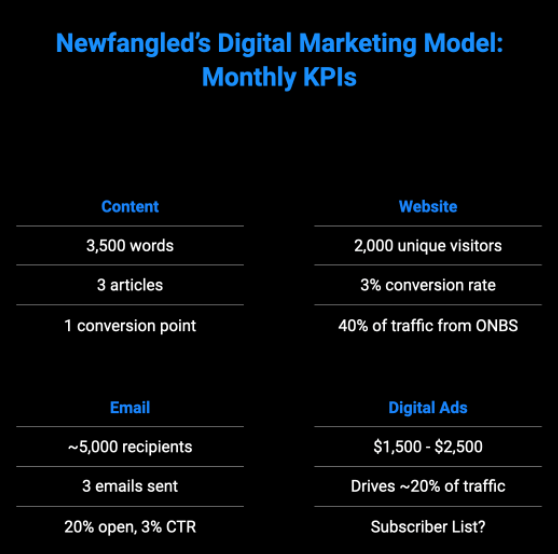For most of the past 20 years, it’s been Newfangled’s position that investing in digital ads was unwise for professional service firms.
Ads were short-sighted. Buying and placing digital ads was easy, anyone could do it. There was no craft or strategy in it. They were expensive. Maybe they cheapened your brand. Why buy your way into the top spots on Google’s SERPs when you could earn them, and own them over the long haul, for free? The very first episode of our podcast was about how investing in ads made no sense because the day you spent your last ad dollar was the last day you’d see any value from them. Ads were for the lowly, desperate, commoditized firms out there who didn’t have anything particularly interesting to say, and therefore had no choice other than to buy some attention.
Experts, on the other hand, wrote. Experts spoke. Experts earned the trust of Google and their ever burgeoning email list through sharing their brilliance and being discovered and revered for it.
It’s true. Experts do those things. What’s also true is that those things take time––increasingly more time as the volume of pages Google indexes and our inboxes get more crowded each year. Marketing has and always will be a long game, and the winners are focused, consistent, and patient. But who doesn’t want to see better results, faster?
We Have Changed Our Minds
Just about everything I wrote about ads in the above paragraph isn’t true anymore. Maybe some of it never was. What we know today is that an expertly executed intricate, precise, and nuanced ad strategy is incredibly impactful. Most importantly, though, it is fast.
You still have to maintain your long term focus on building an audience through the purely earned, inbound means of creating fantastic, insightful content. You still have to wait for Google to slowly drive more and more right-fit prospects to it. And, you still have to proactively deliver your expertise to an email audience who is slowly warming up to it. These things are still essential, but investing in paid media is going to have a near term, positive impact on all of these things, which I will detail in this article.
Marketing is a constantly evolving discipline. We want the absolute best for all of our clients. They trust us with so much, and we take their investment in us very personally. At any given time we are working directly with 80+ firms on a monthly basis. Because of that, we see trends and patterns no one else can. It is our professional responsibility to make sure we’re properly allocating every dollar and hour our clients invest in us as shrewdly as possible.
The trend of purely organic, expertise-based, earned marketing taking longer and longer to generate results surfaced for us and, to be completely honest, it kept me up at night. Generating business results is what we do for our clients. When we start to see signs of our methods not working as quickly as we’d like them to, we have to evolve.
Change: The Nature of the Business
Newfangled has become known in the community as a regularly evolving entity. We’re proud of that, but the truth is, it’s painful. Change is very difficult, but it’s easier than dying. If we didn’t evolve at the pace we do (with a major development in our expertise and offering happening every 18-36 months), we would not survive.
In 2012, we branched out from our web development roots of 17 years and created a distinct area of expertise in the firm around Marketing Automation. In 2013, we added CRM consulting. In 2016, we created a dedicated department around Content Strategy and transitioned from website development to website consulting (which was a much bigger deal than it reads here).
Now, in 2020, we have created a dedicated area of discipline around diversified paid media.
We have achieved this not only by leveraging the experience of our Demand Generation Strategists around LinkedIn display ads but also by creating a new role at Newfangled. Jayson Conway, our new Director of Digital Engagement, is a senior paid media expert who brings more than a decade of experience in paid media across all digital platforms. Coupling Jayson’s deep expertise in paid media strategies and technology with everything we have learned about marketing expertise through primarily earned means is a thrilling combination for us.
Even though the way in which we earn our income in 2020 would be unrecognizable to our 2015 selves, our changes have always been logical progressions, step by step. This new step of fully committing to paid media doesn’t mean we’ve changed our minds about the core marketing principles of content, website, and email strategy. All three of those things are as critical as ever. But paid media is the fuel that rapidly generates the volume of visitors required for those things to operate at maximum efficiency, as quickly as possible.

The Relationship Between Paid Media
and the Flywheel of Marketing
The above KPIs are the general performance traits shared by our clients who have great success with their marketing. For the average small to mid-sized professional service firm out there, these numbers will seem astronomical. The typical firm publishes very little content, has well fewer than 1,000 unique visitors per month, and has less than 1/10th of the recommended email list size. Getting from where the average firm is today to the above benchmarks is more difficult than ever, due to the mass volume of content and email being published and sent.
If you decide that you need to market to ensure the long-term success and stability of your business, you’re likely going to have to figure out how to get from point a to point b. There are really only two levers you can pull: you can earn your way up to these numbers, or you can buy your way up to them. Or, you can pull both levers –– something I believe is required. Now, we’ll go through each of the above disciplines, look at the KPIs, and review what pulling both levers looks like.
Website: The Gatekeeper
Monthly KPIs:
2,000 unique visitors
3% conversion rate
40% of traffic coming from organic non-branded search
Your site is still your marketing temple. It is where you want to drive all of your traffic. The primary roles of attracting, informing, and engaging your prospects hasn’t changed since I published my book about this 9 years ago. The benchmark of 2,000 unique visitors per month means that you’d see roughly 100 visitors per weekday. The typical firm has 30 or so. In the past, if you hit the content and email benchmarks listed here, you could rely on earning your way from 30 to 100 unique visitors over the course of the first 6 months of executing your content and email strategies.
This is no longer true. Google takes longer and longer to trust and favorably rank new content, and email recipients are more skeptical than ever. Over time, Google will reward you for your content effort (if it is fantastic), and your email list will warm up. But how much time do you have?
Spending the recommended $1,500-$2,500/mo. on ads in an extremely careful and ever-refining way is the single most potent thing you can do to drive the most highly qualified traffic to your site as quickly as possible. But what happens when they get there? Has your site been built to foster the ideal Prospect Experience? Is it full of insightful, empathetic, expert content? Does it have a myriad of conversion forms geared toward prospects in the research and evaluator stages of the buy cycle? If so, the right prospects will convert. Through that action, they will be added to your email list, and the site’s primary job will be done (and done well). If you simply buy a bunch of ads and do none of the rest, you’ll waste nearly all of your ad spend.
Organic Search: Not so ‘Organic’ Anymore?
One of the most prominent ways ads impact the rest of your marketing has to do with the KPI related to traffic. High performing sites receive at least 40% of their traffic from organic, non-branded search. Google has forever promised that your Google Ad spend and your organic rankings for your content have nothing to do with each other. We’ve always believed that. Maybe that’s still true. What we do know, though, is that ads have a definite impact on your organic traffic.

The above graphic, pulled from one of our client’s data sets, shows a clear rise in organic traffic during their peak ad investment. The only thing that substantially changed over this time period was the ad spend. Same site, same content, same SEO, same everything.
When reviewing client and peer data over the past six months, we’ve not seen a single exception to this. When you buy ads, your traffic from organic search rises accordingly, and when you stop the ad purchase, it goes back to its normal level.
Why might this be? The increased brand awareness ads create certainly accounts for some of this. Searchers who see your ad (even if they don’t click the ad) become more aware of your brand and organic listing. By the time they get to your organic link on the SERP, they may have already seen your ad higher up on the page, and you’re slightly more of a known entity as a result. It’s also possible that someone who has previously been exposed to your site (maybe through an ad) is more likely to click your organic listing when they search again.
This is not to say that buying ads is the only way to increase organic traffic. You can definitely still build a fantastic traffic base through your content strategy efforts alone, it just takes much longer than it used to.
This magnifies the importance of a decent ad spend in the early days of executing your new site, content, and email strategy. Paid ads––particularly Google Ads––raise all boats; you receive more traffic from more sources when you invest in Google Ads.
Content Strategy: The Convincer
Monthly KPIs:
3,500 words per month
3 articles published
1 conversion point
Your content strategy, which consists of your firm creating thousands of words of highly targeted, empathetic, educational content each month, is still the heart of your marketing. We’ve said many times that your expertise is your only true marketable asset, and that is as true as it ever was. Content is required for your prospects to initially find value in your firm and it eventually will drive thousands of right-fit prospects to your site each month. Your expertise (content) is the force that sets the flywheel of marketing in motion. Buying ads does not replace the need for content. Ads are critically important to ensure that enough prospects are seeing your content between the time you launch your new marketing strategy and the time it takes your marketing flywheel (which is primarily composed of your organic SEO and email efforts) to start spinning on its own. Once the flywheel is moving rapidly under its own power, you can make a very well educated, data-based decision about the ROI you’re continuing to get from your ad investment. It will be apparent.
Email: The Nurturer
Monthly KPIs:
~5,000 recipients
3 emails sent
20% open rate
3% click-through rate
Email has borne the brunt of much marketing scorn over the years. It has been proclaimed ‘dead’ over and over again. But it’s not dead, and won’t be anytime soon. The rules of effective email use, however, have changed dramatically in recent years.
It used to be that you could buy a list, start sending your great content to that list, and expect numbers somewhat in line with the KPIs above in relatively short order. This is no longer true. Email is no longer a reliable mass ‘cold opener’ tool, no matter how good you are at it. It is, however, the single most essential tool you have to nurture relationships with your prospects at scale once they have initially engaged with you. Email, like content, is as necessary as it’s ever been, but it cannot be relied on in the same way it was in the past.
The average firm has around 300 or so email subscribers––a far cry from the recommended 5,000. ‘Earning’ your way from 300 to 5k through purely inbound, opt-in means is simply impossible today. It will not happen. It is for this reason that we’ve been working very carefully with our clients to buy well-targeted, cleansed email lists. After the list purchase, we create an extremely intricate system for slowly but effectively warming that list up. This works, over time.
Paid media can have a sea-change-level impact on email list acquisition and nurturing. For many firms, it may be possible to take the ~$5k you would spend on an email list and instead invest that money in highly strategic and targeted ads that drive prospects to voluntarily opt-in to your content. For some firms, it is possible to get around 2,500 opt-in subscribers for the same amount of money it would cost them to buy the same sized list! Considering how long it takes to warm up a purchased prospect to engage as regularly as an opt-in prospect, this is major news. Yes, it is very nice to simply buy a few thousand emails and have your list size increase by 10x overnight. But for many firms it is quite likely that they’ll get more prospects engaging at a higher level, faster, through a paid media list building strategy than a simple list purchase.
Paid Media: The Accelerant
$1,500 – $2,500/mo. spend
Our recommended spend of $1,500 – $2,500 is the amount required to give your ads a fighting chance. If you spend less than this, it’s likely you won’t see enough results to make a fair performance assessment. If you spend more, you may waste more ad spend than necessary in the early trial and error stage. For most small to mid sized firms in North America, this represents a reasonable portion of their overall monthly marketing budget. In summary, your ad spend, if managed by a seasoned expert, has a strong chance of exponentially increasing the ROI of the rest of your marketing investment.
The last benefit I’d like to cite here is the near immediate impact your ads will have on your marketing strategy. When you execute a content strategy, it can take a number of quarters to amass enough data to start making reasonable decisions about which topics and audience segments are the most lucrative to focus on. When you run a certain volume of ads through Google, Facebook, and LinkedIn, you get back a lot of data in a very short amount of time. In the hands of an expert, this data is gold. This is very real, immediate, and custom market research. To get custom research this good and actionable, you’d have to pay at least as much as the ad spend!
You will gather learnings in the first few months of running ads that will have an immediate and positive impact on your content, email, and website strategy.This alone would be reason enough to seriously consider the ad investment. As it is, though, it’s almost a footnote compared to the other benefits covered throughout the rest of this article.
Without the Struggle, What Would We Have?
Earlier in the article I mentioned the pain associated with having to evolve our services every 18-36 months. It is hard and challenging, but it’s a professional responsibility we’re deeply grateful for. If nothing ever changed, this wouldn’t be nearly as fun and, truthfully, Newfangled probably wouldn’t need to exist. We take great pride in our work and feel that we are an important part of the community we serve. Helping people like you stay on top of your marketing game brings us great joy. Everything we have taught you individually, we have learned from you collectively, and we love every minute of it.

